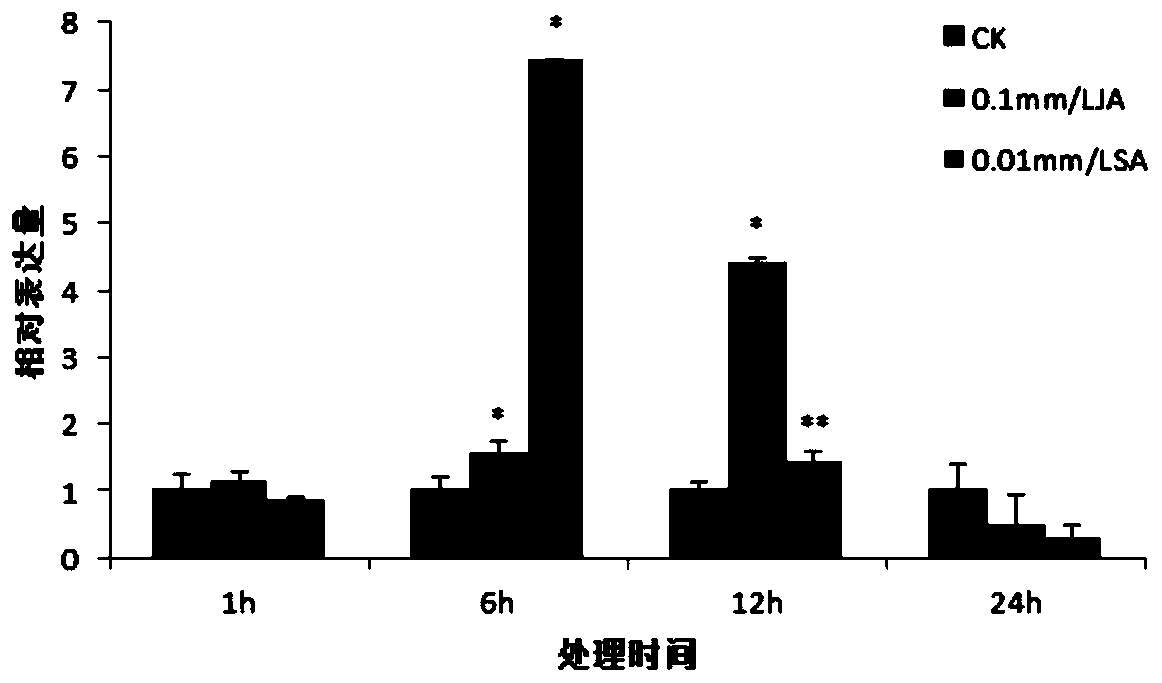Application of Verticillium Wilt resistance-related gene GhSDH1-1
A technology related to cotton verticillium wilt and resistance, applied in the field of application of the gene GhSDH1-1 related to cotton verticillium wilt resistance, can solve the problems of low selection efficiency, long cycle, and affecting cotton yield
- Summary
- Abstract
- Description
- Claims
- Application Information
AI Technical Summary
Problems solved by technology
Method used
Image
Examples
Embodiment 1
[0025] Example 1 Acquisition of cotton gene GhSDH1-1
[0026] Using the resistant variety Zhongzhimian 2 and the susceptible variety Jimian 11 as plant materials, after inoculating cotton Verticillium wilt pathogen Vd080, through metabolomics analysis, it was found that after Verticillium dahliae infected cotton, the root cells The accumulation of succinic acid decreased significantly, while the accumulation of fumaric acid increased significantly. Further, through the gene analysis and pre-test of succinate dehydrogenase, it was found that the expression level of the gene GhSDH1-1 was significantly increased after the resistant variety was inoculated with Verticillium dahliae, which constitutes succinate dehydrogenase (SDH) Subunit gene, so named GhSDH1-1.
Embodiment 2
[0027] Embodiment 2 investigates the expression of GhSDH1-1 gene in cotton after pathogenic bacteria and hormone treatment
[0028] The cotton variety Zhongzhimian No. 2 was planted in vermiculite sandy soil paper pots, the roots were inoculated with Vd080 spore suspension, and root RNA was extracted at different time periods.
[0029] Spray with 0.01mM salicylic acid (SA) and 0.1mM methyl jasmonate (JA) until the leaves drip, and extract root RNA at different time periods.
[0030] According to the gene sequence and CDS sequence of GhSDH1-1, the fluorescent quantitative primers are designed as follows:
[0031] GhSDH1-1-F:TGTATCACCATGCACTCCGCTG,
[0032] GhSDH1-1-R:ACTGGCCGGTAATCCAGTCTCA.
[0033] Detect the expression of GhSDH1-1 after pathogenic bacteria and hormone treatment.
[0034] Such as figure 1 As shown, in the disease-resistant varieties, the expression of GhSDH1-1 was up-regulated at all time periods after inoculation with pathogenic bacteria, and the differen...
Embodiment 3
[0036] Example 3 Utilizes virus-mediated gene silencing technology (VIGS) to study the function of GhSDH1-1
[0037] 1. Silencing of GhSDH1-1 in Cotton
[0038] Primers for the GhSDH1-1 silencing vector were designed according to the VIGS primer design principles:
[0039] SDH-VIGS-F: CGGAATTCGAGGACGGAACACTACAT,
[0040] SDH-VIGS-R: CGAGCTCCACGAGACCCTTCAGTAA.
[0041] The silent fragment was amplified using the cDNA of Zhimian No. 2 in the disease-resistant variety as a template, and transformed into TRV-156 vector, and transformed into E. coli DH5α competent cells. After sequencing and verification, the TRV-156-GhSDH1-1 plasmid was extracted, and Transform Agrobacterium GV3101 competent, after the colony PCR verification is correct, expand the culture, use pYL-156 empty load as the control, and TRV-156-PDS as the positive control (after the PDS gene is silenced, the leaves show albinism), and auxiliary After the plasmid TRV-192 was mixed and allowed to stand, the No. 2 cot...
PUM
 Login to View More
Login to View More Abstract
Description
Claims
Application Information
 Login to View More
Login to View More - R&D
- Intellectual Property
- Life Sciences
- Materials
- Tech Scout
- Unparalleled Data Quality
- Higher Quality Content
- 60% Fewer Hallucinations
Browse by: Latest US Patents, China's latest patents, Technical Efficacy Thesaurus, Application Domain, Technology Topic, Popular Technical Reports.
© 2025 PatSnap. All rights reserved.Legal|Privacy policy|Modern Slavery Act Transparency Statement|Sitemap|About US| Contact US: help@patsnap.com



